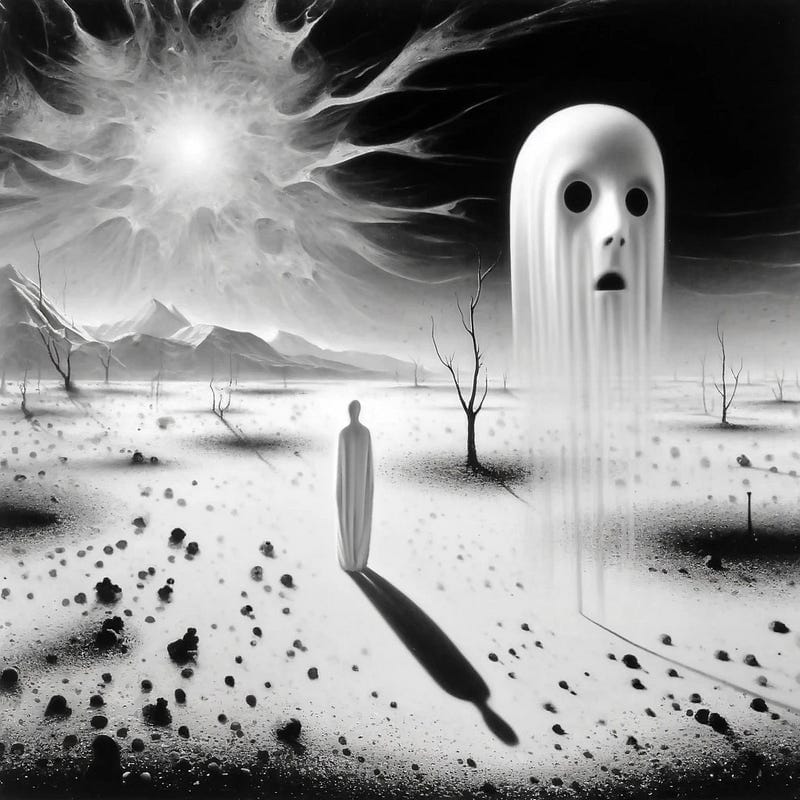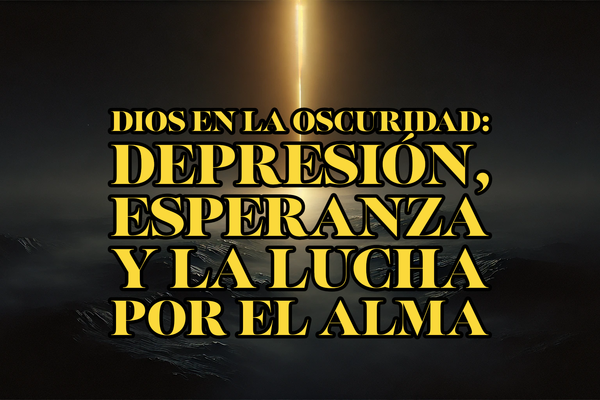Beyond the Veil: Exploring Unawareness in Death through Philosophy, Art, and Literature

Polvo eres y en polvo te convertirás…
Death is a subject that has fascinated humanity for millennia, not just for its finality but for the mysteries it harbors about consciousness and existence. One particularly intriguing idea is the notion of being dead and not realizing it, a concept that has been explored through various philosophical discourses, literary works, and artistic expressions. This article delves into how philosophers, writers, and artists have approached this profound theme, examining the layers of meaning and interpretation that it entails.
From the musings of ancient philosophers to the imaginative realms of modern writers, and the evocative depictions in art and film, the concept of post-mortem awareness invites us to ponder the nature of reality, consciousness, and the afterlife. Whether through the lens of existentialist angst or the surrealist exploration of dreams, these perspectives offer us a rich tapestry of thought and creativity that underscores our perennial curiosity about what lies beyond death.
In this article, we will explore various philosophical theories, literary narratives, and artistic representations that tackle the idea of being dead without realization. By bridging academic insights with accessible reflections, we aim to provide a comprehensive understanding of this enigmatic subject that resonates with both scholars and everyday readers.
Philosophical Perspectives
Ancient Philosophy
The contemplation of death and the afterlife dates back to ancient philosophical traditions. Plato, in his dialogues such as the “Phaedo,” discusses the immortality of the soul and the idea that true knowledge comes from recollecting what the soul knew before birth and will know after death. For Plato, the soul’s journey continues beyond the physical demise, and the awareness of this continuity is paramount to understanding our existence.
The Stoics, on the other hand, approached death with a more pragmatic lens. They believed in the importance of accepting death as a natural part of life. For them, the awareness of death was crucial for living a virtuous life. Marcus Aurelius, in his “Meditations,” often reflects on the transient nature of life and the importance of embracing mortality without fear.
Modern Philosophy
Moving into the modern era, René Descartes’ dualism presents a stark separation between the mind and body. Descartes famously questioned the certainty of all things except the existence of the self as a thinking entity. His meditations bring forth the idea that the mind could potentially exist independently of the body, leading to intriguing possibilities about post-mortem consciousness.
Existentialists like Jean-Paul Sartre and Martin Heidegger further explore the concept of death. Sartre, in “Being and Nothingness,” discusses the idea of “nothingness” and how death brings about the ultimate nothingness, forcing individuals to confront their existence authentically. Heidegger, in “Being and Time,” emphasizes the importance of “being-towards-death,” suggesting that an authentic understanding of our mortality is essential for living a meaningful life.
Contemporary Thoughts
In contemporary philosophy, debates around consciousness and death continue to evolve. Philosophers such as Thomas Metzinger argue that our sense of self is an illusion created by the brain, and thus, the awareness of being dead might be a non-issue since the self ceases to exist. On the other hand, some philosophers and neuroscientists explore near-death experiences (NDEs) and their implications on our understanding of consciousness and the afterlife.
These philosophical perspectives offer a diverse range of views on death and post-mortem awareness, highlighting the complexity and depth of human thought on this universal subject.
Literary Approaches
Classic Literature
Classic literature offers a wealth of insights into the concept of being dead and unaware. Dante Alighieri’s “Divine Comedy” vividly describes the afterlife in three realms: Hell, Purgatory, and Heaven. In this epic poem, souls in Purgatory are often unaware of the passage of time, reflecting the confusion and disorientation that might accompany death.
William Shakespeare frequently explored themes of death and the supernatural. In “Hamlet,” the appearance of King Hamlet’s ghost raises questions about the consciousness of the dead. Is the ghost aware of its state, or is it trapped in a loop of unfinished business? Shakespeare’s use of ghosts and apparitions in his plays often blurs the line between life and death, suggesting a complex interplay of awareness.
Modern Literature
Ambrose Bierce’s short story “An Occurrence at Owl Creek Bridge” masterfully explores the perception of time and reality in the moments before death. The protagonist experiences a vivid hallucination of escaping his execution, only to face the brutal truth of his death. This story delves into the psychological aspects of dying and the mind’s ability to create an alternate reality.
Philip K. Dick’s novels often challenge our perceptions of reality and consciousness. In “Ubik,” characters navigate a world where the boundaries between life and death are fluid, and the deceased communicate through cryptic messages. Dick’s work raises profound questions about the nature of existence and the potential for awareness beyond death.
Contemporary Works
Contemporary literature continues to explore these themes in innovative ways. For example, George Saunders’ “Lincoln in the Bardo” presents a chorus of voices from the dead, each grappling with their state of limbo and unawareness. The novel blends historical fiction with supernatural elements, offering a poignant exploration of grief, death, and the afterlife.
Through these literary works, readers are invited to ponder the mysteries of death and consciousness, as writers use narrative and character to explore the nuances of being dead without realizing it
Artistic Representations
Renaissance Art
Renaissance art often depicted religious themes, including the afterlife and the judgment of souls. Artists like Hieronymus Bosch created intricate visions of Heaven, Hell, and Purgatory, filled with symbolic imagery. These works reflect the period’s theological beliefs and offer a visual representation of the soul’s journey after death, often highlighting the confusion and surreal nature of the afterlife.
Romanticism and Death
The Romantic era brought a fascination with the sublime, the unknown, and the emotional intensity of death. Artists such as Caspar David Friedrich depicted haunting landscapes that evoke a sense of solitude and contemplation of mortality. These works often capture the melancholic beauty of death and the potential for an afterlife that is both mysterious and serene.
Modern and Contemporary Art
Surrealism, as an artistic movement, delved deeply into the unconscious mind, dreams, and the surreal aspects of existence. Salvador Dalí’s paintings, with their dream-like quality and bizarre juxtapositions, often evoke the strangeness of the afterlife and the potential for post-mortem awareness.
In contemporary art, installations and performances frequently tackle themes of death and consciousness. For example, Damien Hirst’s works, such as “The Physical Impossibility of Death in the Mind of Someone Living,” confront viewers with the reality of death and the paradox of contemplating one’s own mortality. These modern representations continue to push the boundaries of how we perceive death and what it means to be aware after dying.
Artistic representations, from the Renaissance to contemporary art, offer a unique lens through which to explore the concept of being dead and unaware. These visual interpretations provide a powerful complement to philosophical and literary explorations, engaging viewers on an emotional and intuitive level that words alone might not reach.
Cinematic Interpretations
Film, as a medium, provides a compelling platform to visualize and explore the concept of being dead and not realizing it. Several iconic movies have tackled this theme, each bringing a unique perspective and narrative style.
The Sixth Sense
M. Night Shyamalan’s “The Sixth Sense” is perhaps one of the most famous examples. The film follows a young boy who can see and communicate with the dead, who are often unaware of their own deaths. The twist ending reveals the protagonist’s own death, challenging viewers to rethink the entire narrative through the lens of post-mortem awareness. The movie masterfully intertwines suspense with profound questions about reality and consciousness.
The others
Alejandro Amenábar’s “The Others” explores similar themes. The story revolves around a woman and her two children living in a seemingly haunted house. The chilling revelation that they are actually the ghosts, unaware of their deaths, underscores the film’s exploration of denial, memory, and the thin veil between life and death.
Ghost
In “Ghost,” directed by Jerry Zucker, the protagonist, played by Patrick Swayze, is murdered but remains as a spirit to protect his loved one. His journey from confusion to acceptance of his death highlights themes of love, justice, and unfinished business, portraying a spectrum of post-death awareness.
What Dreams May Come
Vincent Ward’s “What Dreams May Come” presents a visually stunning exploration of the afterlife, where the protagonist navigates a personalized heaven and hell. The film delves into metaphysical concepts, emphasizing the power of love and the soul’s journey after death.
These films, influenced by philosophical and literary traditions, provide a vivid and emotionally resonant depiction of the idea of being dead and not realizing it. They invite audiences to engage with profound existential questions through the immersive experience of cinema.
Personal and Cultural Reflections
The perception of death and the afterlife varies significantly across cultures, each offering unique insights into the concept of post-mortem awareness.
Cultural Beliefs
In many Eastern traditions, such as Buddhism and Hinduism, the cycle of death and rebirth (samsara) is a core belief. These religions emphasize the transient nature of life and the possibility of reincarnation, where the soul may or may not be aware of its past lives. Rituals and practices often aim to guide the deceased towards a favorable rebirth or liberation (moksha).
In contrast, Abrahamic religions like Christianity, Islam, and Judaism typically view death as a transition to an eternal afterlife, with heaven and hell as destinations. These faiths often involve the soul’s judgment and awareness of its deeds during life, impacting its eternal fate.
Near-Death Experiences
Personal narratives and memoirs about near-death experiences (NDEs) provide contemporary insights into post-mortem awareness. Individuals who have experienced NDEs often describe sensations of floating, seeing their own body, and encountering a bright light or deceased loved ones. These accounts suggest a form of awareness beyond physical death, sparking debates among scientists, philosophers, and theologians about the nature of consciousness and the afterlife.
Influence on Art and Literature
Cultural beliefs significantly influence artistic and literary depictions of death. For example, Mexican traditions surrounding Día de los Muertos (Day of the Dead) celebrate deceased loved ones, reflecting a view of death as a continuation rather than an end. This celebration has inspired vibrant art, literature, and cinema, emphasizing remembrance and connection.
By examining these personal and cultural reflections, we gain a broader understanding of how different societies grapple with the concept of being dead and unaware, enriching our global perspective on this profound human experience.
The concept of being dead and not realizing it captivates our imagination and challenges our understanding of consciousness and existence. Through the lenses of philosophy, literature, art, and film, we explore the myriad ways humanity has grappled with this enigmatic theme.
Philosophers from Plato to Heidegger offer profound insights into the nature of death and awareness, each contributing to a deeper understanding of our existence. Literary works, from Dante’s “Divine Comedy” to modern novels, weave narratives that probe the boundaries between life and death. Artistic representations, from Renaissance depictions of the afterlife to contemporary installations, visually evoke the mysteries of post-mortem consciousness. Films like “The Sixth Sense” and “The Others” bring these ideas to life on screen, engaging audiences with their emotional and philosophical depth.
Cultural beliefs and personal experiences further enrich our exploration, highlighting the diverse ways societies perceive and relate to death. Whether through religious rituals, near-death experiences, or cultural celebrations, these reflections offer a mosaic of perspectives on the possibility of awareness beyond death.
Ultimately, the exploration of being dead and not realizing it invites us to confront our mortality and the profound questions it raises about consciousness, reality, and the afterlife. By engaging with these themes, we not only deepen our philosophical and artistic understanding but also enrich our appreciation of the complex tapestry of human existence.



